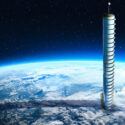From space, it would look like Earth had a giant pimple. Smack dab in the middle of Brazil. Back on the ground, you’d be astonished by the enormity of Olympus Mons. The tallest mountain in our Solar System. Which also happens to be a massive volcano. If this Martian colossus was located in South America, how catastrophic would its eruption be? Why would you never experience an earthquake? And why would countries start wars over this epic mountain?
No other mountain in our Solar System rises above the 25 km (15.5 mi) height of Olympus Mons. To put that into perspective, Olympus is over two and a half times taller than Mount Everest. And this flat-top giant isn’t only tall. It’s also really wide. On Earth, the base of Olympus Mons would cover Ecuador entirely. But here’s a twist. For a volcano this large to form on our planet, Earth would need some big changes under its crust.
Deep in our planet’s mantle, there are areas that are unusually hot. These are known as hotspots. From these hotspots, large amounts of magma rise, breaking through the Earth’s crust. And that’s how volcanoes are formed. But because Earth’s crust is made up of moving tectonic plates, a volcano will eventually move away from the hotspots that formed it and, as such, stop growing.
That’s why a volcano as large as Olympus Mons could never be formed on the Earth we know today. The reason why Mars is able to house more massive volcanoes is that, unlike our planet, it doesn’t have these moving tectonic plates. This means that on Mars, volcanoes remain on top of their hotspot and continue growing.
Now, take away the Earth’s tectonic plates, and we could grow our own Olympus Mons. And on the bright side, no tectonic plates would mean no earthquakes, ever. And we’d likely still live on the first supercontinent, Rodinia. That’s because the plates wouldn’t move and break the land into separate continents like we have now.
Now on the not-so-bright side, this supervolcano could cause some damage. How long would we have before it rained fire and ash over humanity? Well, not all volcanoes are the same. And we might have a chance to survive Olympus Mons erupting. So you shouldn’t judge a book by its cover, or a mountain by its size. Olympus Mons is a shield volcano.
That means it doesn’t chaotically spew melted rock out, causing planetary destruction in the process. When volcanoes like Olympus Mons erupt, it usually isn’t a violent explosion. Instead, they tend to produce a steady and long-lasting flow of lava. And that’s good news. Lava flows are easy to spot, predict and avoid. So there wouldn’t be a catastrophic apocalypse when Olympus Mons went off.
It might not even have a major impact when it comes to climate change. That’s because shield volcanoes don’t release much gas or debris. Lucky you. And just to sweeten the deal, Olympus Mons wouldn’t erupt today. The last time would’ve been between 20 and 200 million years ago. The dinosaurs wouldn’t have fared so well, though.
Many would have died due to constant volcanic eruptions. But wait, there’s more. Living around Olympus Mons could bring you lots of cash. That’s because the ground around this grand volcano’s base would be rich with minerals from its basaltic magma, including magnesium. This would seriously improve the quality of agricultural soil.
Time to get into the agricultural business. And that’s not all. Even if the volcano is active, it creates geothermal energy. Just like some cities in the U.S. currently generate electricity from smaller volcanoes. And you can bet it would be a year-round tourist attraction. But now, hold off on your victory lap. An Earthly Olympus Mons would bring some problems with it.
Man-made problems, to be precise. Volcanoes produce natural resources like diamonds, gold and nickel. So naturally, South American countries that share portions of Olympus Mons would see a steep increase in wealth. And like history has shown, violent and destructive conflicts over these resources would be inevitable. Just like diamonds fueled civil wars in Africa, which lasted over a decade and left thousands dead.
South America’s long history of social and political unrest would be aggravated by Olympus Mons’ treasures. Around it, blood could flow much more commonly than lava. So keep Olympus Mons where it belongs, on Mars. If anything, you need to watch out for the supervolcano at Yellowstone Park. That baby sure is active and its eruption would even make breathing a hazard.
Sources
- “The Tallest Volcano On Mars And The Deepest Asteroid Crater”. Hobart M. King, PhD, RPG. 2022. geology.com.
- “The Tallest Mountains In The Solar System”. Sarah Zielinski. 2012. smithsonianmag.com.
- “The Orographic Effect | EARTH 111: Water: Science And Society”. 2022. e-education.psu.edu.
- “Mount Everest | Height, Location, Map, Facts, Climbers, & Deaths”. 2022. britannica.com.
- “Olympus Mons: Giant Mountain Of Mars”. Nola Taylor Tillman. 2017. space.com.


























